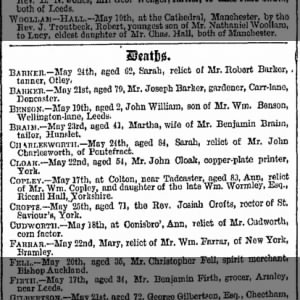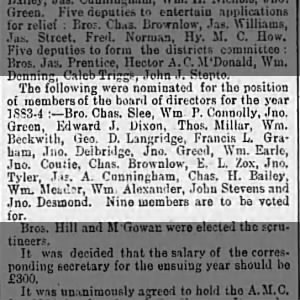
It feels great to find an ancestor in the newspaper—whether it’s in an obituary, marriage announcement, or other type of notice. But sometimes historical newspapers used abbreviations and terms that are no longer common, leaving some of us scratching our heads.
To help you get the most out of historical newspapers, we’ve come up with a list of some of the most common abbreviations and terms:
 Relict – This term is used to describe a surviving spouse, often a widow. It comes from the Latin term “relictus,” meaning “relinquished” or “left behind.”
Relict – This term is used to describe a surviving spouse, often a widow. It comes from the Latin term “relictus,” meaning “relinquished” or “left behind.”
- Née – This term is French and means “born.” It is used to indicate a woman’s maiden name.
- Instant (Inst.) – This is used to refer to the current month. For example, a newspaper article published in December that says “12th inst.” means December 12th.
- Proximo (Prox.) – Essentially meaning “next,” this is used in newspapers to indicate the upcoming month. So “12th prox.” in a December newspaper would mean January 12th.
- Ultimo (Ult.) – This refers to the previous month. A December newspaper that says “12th ult.” is referring to November 12th.
- Old style/New style (O.S./N.S.) – These terms refer to dates that are either prior to approximately 1752 (“old style”) or after about 1752 (“new style”). This is because in 1752, Britain (including its American colonies) adopted the Gregorian calendar, which resulted in skipping 11 days that year. To make matters even more complicated, the first of the year was moved from March to January. So to remove confusion, newspapers around the time of the change included “O.S” or “N.S” to indicate which system was being used for the dates they provided.
 Name abbreviations – Name abbreviations are common in old newspapers. Some abbreviations are merely the first few letters of the name followed by a period, while others are contractions (the first part of the name plus the final letter). Some abbreviations are derived from the name’s Latin equivalent, which makes them a bit trickier to decipher. Below are the most common name abbreviations:
Name abbreviations – Name abbreviations are common in old newspapers. Some abbreviations are merely the first few letters of the name followed by a period, while others are contractions (the first part of the name plus the final letter). Some abbreviations are derived from the name’s Latin equivalent, which makes them a bit trickier to decipher. Below are the most common name abbreviations:
- Chas – Charles
- Wm – William
- Geo. – George
- Jno – John
- Jas – James
- Thos – Thomas
We hope you found the explanation of these terms and abbreviations useful! Get started searching or browsing historical (and modern!) papers on Newspapers.com.


Thanks for creating a “one stop shopping” guide to those common terms that I frequently forget. It is nice to see these reminders that I can copy and paste into a word document to keep handy when I’m doing research. Many thanks.
Julie
Thank You. I printed out for future reference.
I always enjoy a refresher course.
Two more old name abbreviations are Hy. for Henry and Fras. for Francis.
Others – N.B. usually seen in legal docs, essentially to mean “Note”. “viz.” essentially to mean, such as….
With regard to “viz.” I’d suggest “namely” is a better substitute than “such as,” since “such as” leaves room for additional examples. Since it’s often used in wills to list heirs, I think it’s not meant to be open-ended.
Are there any for females? I know the nicknames are also maddening.
Sadly, females got short shrift. Any that were married were usually called by their husband’s name (Mrs. John Smith)–even in their obituary! Those that weren’t married got even fewer mentions.
This policy must end. We are liberated!
It did end a few decades ago. But we can’t change historical papers. 🙂
Off the top of my head, all I can think of are Eliz. for Elizabeth and rarely, My. for Mary.
Or Eliza.
Which might mean Elizabeth or might mean Eliza!
During searches in my spouses family, I run into Eliza alot in the Census. At first it threw me, then it hit me that it was Elizabeth.
Betty
Liz
Yes, those are common nicknames, but I was referring to abbreviations used in old newspapers. There weren’t a lot of abbreviations used for women’s first names.
Liz, Beth, Ellie all for Elizabeth
Again, these are good nicknames for Elizabeth. But the focus of this thread is on abbreviations, not nicknames. Since women were seldom referred to in print by their full names, but rather as Miss or Mrs. followed by their maiden or married surname, there aren’t a lot of abbreviations for women’s given names.
I get it….I had replied to Cathy Pensyl regarding abbrev in early census’
Peggy -Margaret
Dot -Dorothy, Dorothea
Lottie – Charlotte
Bridie – Briget (and variations)
May or Polly – Mary
Fannie – Frances
Hattie – Harriet
Kate, Kitty – Catherine
It’s also helpful to search for initials for men (e.g. A. B. Smith).
Peggy=Margaret
Winnie = Winifred
Nellie = Eleanor
We have a friend called Polly, whose real name is Pauline.
Sadie – Sarah
What does this phrase mean–“Gentlemen’s List E under ‘List of Letters Remaining in the New York Post Office, Persons calling for advertised letters will please mention the date of the list on which their letters are
advertised.'” Does it mean just what it sounds like–letters that have not yet been picked up from the Post Office?
If you look at some of the old newspapers, they have lists of addresses of unclaimed mail.
“Et ux”, which means “and wife”.
Finally, a good explanation of Instant, Proximo, and Ultimo. It’s Instant which has always caused me confusion–being not always easy to figure out from context.
This would be a good ad for newspapers.com on Facebook. especially in the genealogy groups.
I really do love Newspapers.com. Your marketing campaigns are excellent – informative and fun. And “Fishwrap” – this too is great!
Enjoyed these news tips and hints Can I post them on our Baltimore County Genealogy Society (Maryland) newsletter if I give the source for them and permission granted.
This is quite nice – newspapers.com has helped me tremendously; There are a lot of nuts in my tree that are hard to crack and with newspapers.com, I was able to crack…only to learn it’s all relative
Speaking of nuts, I found an ancestor of mine who was actually named “Almond”.
That’s probably “Almon” though I’ve seen that name spelled by census enumerators many times as “Almond.”
I am a member of the newspaper.com but Every time I try to get on I have trouble getting on. This is so frustrating and I am paying money for this. I need to know how to get on the site easier.
There are some key missing weeks and months for some newspapers. To name two, they are the Poughkeepsie newspapers the “Eagle” and the “Journal”. I hope these missing listings will be a priority in some upcoming updates.
Also, the Kingston Daily Freeman. Many dates I researched had only every other page. It’s very frustrating.
I find newspapers.com frustrating. My searches mostly come up with nothing. I know I’m doing something wrong, but what?
I’ve had very good luck with newspapers.com. I’d be happy to work with you to improve your search strategy. You can contact me at kjostew@verizon.net if you’d like.
Thanks very much, Karen! I’d appreciate it very much. I’ll email you. ~ Elizabeth
What a nice reach-out.
Thank you, Karen! I appreciate it very much. I emailed you. 🙂
Ah ha! I now know that Jno IS actually my ancestor John!
(I am new to the genealogy searching.) Thanks for the tips!
Jno is also Jonathan.
Thanks for the meaning of many abbreviations. Keep up the good work.
I have encountered some difficulty in using newspaper.com When I have multiple hits with a word search I am not returned to the same place in the sequence after bringing up the precise word on a full newspaper page and returning to the small picture of the word as it appears in the list of multiple hits.
Another abbreviation: Jos for Joseph.
Thanks for the explanations. They are very helpful. I love newspapers.com and have gotten so much out of it. I only wish they had more 19th and early 20th c. newspapers from northern N.J.
Bella for Isabella
Another abreviation is “Hon” for honorable in reference to a current or former legislator and other state government office holders. In my case, I had a relative named Asa who had served as a legislator whose grave marker has
“Hon Asa F…….”. Many transcribers got that wrong and claimed his name was ”Honasa”.
That’s really kind of funny.
I
Am glad to have this refresher course. It helps so much to know what abbreviations mean to have complete meaning where they occur. I would like a description for the word “inmate”. Does it refer to criminal, incompetent, or mentally handicapped person?
If you’re finding the word “inmate” on a Census, scroll to the top of the image of that census to see which institution it is. One of my ancestors was listed as an inmate, and I found at the top of the page that she was living at the Lincoln State School and Colony. She was there with two of her sisters. I don’t know if they did censuses of the prisons. Unless you can pin down the nature of the institution, it’s going to be difficult to define “inmate” in much detail. Most of the institutions back in the “old days” served incompetent, incorrigible, “insane,” and mentally handicapped populations.
Am glad to have this refresher course. It helps so much to know what abbreviations mean to have complete meaning where they occur. I would like a description for the word “inmate”. Does it refer to criminal, incompetent, or mentally handicapped person?
inmate could be anybody living in some kind of group home.
Or someone who is institutionalized, such as you described above.
Regarding name abbreviations, “Jno” is usually the abbreviation for Jonathan, not John which is a completely different name.
How did my email address change from gmail.com to newspaper.com? I don’t remember giving permission or asking for this change. Help please!!
Christopher and Christian have very similar abbreviations that are easy to misread in hand written lists. Christ followed by a superscript “r” for Christopher and Christ with a superscript “n” for Christian.
A couple that I have come across
Br. – British
Br. Am. – British American
Ch. can also be used for Charles
and for those of you who may not know this:
Mrs. actually is an abbreviation for mistress, not misses (notice, no “r”) 🙂
For those that are tracing relatives that were maritime workers, or traveled here from overseas:
S.S. – steamship
R.M.S. – Royal Mail Ship
spt. – seaport
mar. – maritime
oc. – ocean
Anyone who has a knowledge of official abbrevs, no nicknames (there is a difference) please post. They can be helpful when searching old papers.
I understand using abbreviations when writing with a quill pen or an ink pen that must be loaded by dipping into an ink well constantly. However, in this day and age with the convenience of writing instruments available I see no need to use abbreviations. Perhaps in a few instances where the same word is used constantly but in general I prefer to spell it out.